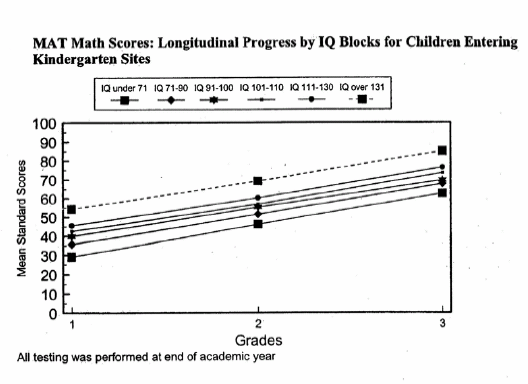Kevin Carey, of The
Quick and the Ed fame, reviews Linda Perlstein's
Tested in the
Washington Monthly.
I've been down this road already and
was not impressed with Perlstein's thinly veiled agenda and shoddy scholarship.
As Carey points out, Perlstein went to Maryland's Tyler Heights Elementary School, a school "built near the low-income housing projects of Annapolis," to take an in-depth look at the school that
more than doubled its pass rates on state reading and math tests in just three years, moving off the list of schools tagged as low-performing by the No Child Left Behind Act. Politicians, school officials, and newspapers like the Washington Post held up the school as a "crown jewel"—an example of how NCLB can help even the most disadvantaged children learn.
When she got to Tyler, Perlstein didn't like what she saw:
The teachers are required to use a highly structured, sometimes scripted curriculum. Science, art, and social studies are often ignored in favor of the tested subjects, reading and math. And the test prep is relentless—over and over, students practice writing the "brief constructed responses" (short written paragraphs interpreting a text) that feature prominently on the state exam.
She contrasts this "rudimentary education" to the superior education that she believes is being offered at the Crofton Elementary School "located in a wealthy planned community just fourteen miles away [from Tyler]."
Crofton students spend their days writing in journals, making crafts, studying science and history, and so on. There's little test prep, but nearly every child passes the exam. The contrast is a gross injustice, Perlstein believes.
In one sense, I agree with Perlstein that the massive test prep that's being done at Tyler is counterproductive. However, unlike Perlstein, I do not believe that "writing in journals, making crafts, studying science and history, and so on" represents a superior education over the "highly structured, sometimes scripted curriculum" being offered at Tyler.
As Kevin Carey points out, the need for scripting and structure depends on the needs of the students, not on Perslstein's personal biases. In order to teach the kind of low-performing students that go to Tyler, a school needs to get all its ducks lined up perfectly. Often it is only possible to do this in a highly structured and scripted environment
because most teachers simply do not have the skills needed to educate these kids when left to their own primitive devices. It is extremely difficult to get these kids to learn a year's worth of material in a year's time using every available instruction minute, let alone when significant instructional time is wasted on the low-value fluff that Perlstein and Crofton favor. Upper-middle class kids can afford to waste some instructional time, lower and lower-middle class kids do not have such a luxury.
This is the great conceit in education. People like Perlstein and the Crofton educators think they know the first thing about educating lower performing students. They don't. All they know is folklore, opinion, and anecdotes from their own education. The disaggregated data tells a different story because unbeknownst to Perlstein schools like Crofton have a couple of poor and minority kids. Let's see how well the rainbow and lollipop curriculum at Crofton has served these kids.
Here's the
MSPAP scores for Crofton in 2006.
| Crofton | Reading | Math |
| White | 96.7 | 97.0 |
| Black | 83.3 | 72.2 |
| Hispanic | 100.0 | 100.0 |
| Poor | 80.0 | 70.0 |
Here are the
MSPAP scores for Tyler in 2006.
| Tyler | Reading | Math |
| White | 100.0 | 100.0 |
| Black | 86.8 | 82.4 |
| Hispanic | 90.9 | 87.0 |
| Poor | 87.9 | 82.1 |
With the exception of Hispanics, Tyler outperformed Crofton, often substantially, in both math and reading. And, bear in mind that the blacks and poor students in Crofton are far more likely to be middle class than the ones coming from the projects surrounding Tyler. This masks a large structural advantage that favors Crofton considerably. Yet, Crofton squanders this advantage.
If this were a football game, Tyler would be getting a large point spread. Crofton has not only failed to cover the spread, Tyler has won outright.
If the Crofton education is so superior to the rigid scripted curricular offerings at Tyler, than why can't the Crofton kids demonstrate their superior ability on a simple test of basic skills?
Perlstein is merely perpetuating the big lie in education started by people like Kopzol and Rothstein. The lie that affluent schools know how to educate lower performing students. They don't. And, time and again, the disaggregated data coming from NCLB shows that they don't. Yet, people like Perlstein, Kozol, and Rothstein are unable to provide an explanation for this discrepancy. Their idea of reform is to get rid of NCLB. In other words they want to get rid of the inconvenient data that shows they don't know what they are talking about.




